
Interview with Don Williams of the Blackhawk Collection
VT: Perhaps you can address some of our reader’s comments from last week. One reader stated that a collector car has to have something unique, style, power, handling, innovative design and implied the Red Flag did not meet those standards.
DW: How much more unique can you be than to have the first Red Flag exchanged in the United States with China, one of the first cars built by China, and the car which exemplifies the start of cultural sharing and automotive exchange between the United States and China if not the world.
VT reader: “Vultures in a soft economy looking for the next untapped market. They have nothing worthwhile trading for. That only means the loss of more classics from the western market to the far east. It’s the money these people want. It’s no longer about the love of old cars.”
DW: I was accused of this when selling to Japan in the 80’s and now more than half of those classics are back in the United States. It’s two way trade; they are car collectors too in Japan now. It’s one world.
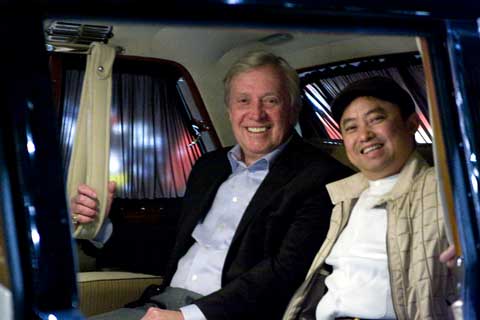 Don Williams and Jason Huang taking a seat in the back of the Red Flag Limousine at the exchange ceremony at Blackhawk Museum December 10, 2008.
Don Williams and Jason Huang taking a seat in the back of the Red Flag Limousine at the exchange ceremony at Blackhawk Museum December 10, 2008.
VT reader: “These cars [western classics] are part of Western Civilization. Are we going to sell our history to a place who’s greatest achievement in the past 60 years has been keeping Wal-Mart stocked with cheap crap?”
DW: Obviously he hasn’t been to China. Look at computers we work on, the TVs we watch. Almost every company in the U.S.A. is in China. VW was the first, but now all the world is there. You don’t have to shop at Walmart to see Chinese goods, go to Nordstrom’s, where there are products from China as well. Again, it’s one ever increasingly small world.
VT: What is the proper way to address, acknowledge, or deal with issues relating to the still-Communist government in China?
DW: People can’t learn to understand each other unless they talk. Capitalism is alive and well, China is changing month after month. We must be ready to accommodate and understand the future as well as the past.
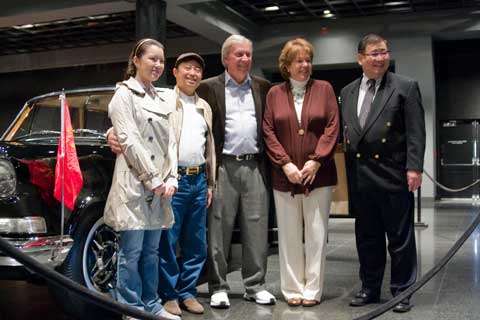 Don and his wife celebrating the Red Flag exchange.
Don and his wife celebrating the Red Flag exchange.
VT: What are the issues with importation and exportation of classic cars in China?
DW: They are many and they are difficult. There are anti-dumping laws, and no used cars are allowed into China. They are finally making exceptions for museum displays so people can share automotive history like they do in the United States and elsewhere. It’s going to take time to overcome the many hurdles. It’s a slow process, and the Red Flag is only the start of a greater car exchange.
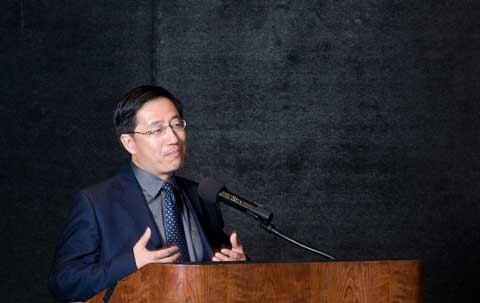 San Francisco Chinese Consulate expresses sincere pleasure at the start of two-way cultural car exchange between China and the U.S.A..
San Francisco Chinese Consulate expresses sincere pleasure at the start of two-way cultural car exchange between China and the U.S.A..
VT: What are the cultural and social differences between Japan and China relevant to the hobby of car collecting?
DW: They are very similar. Using Japan as an analogy for both countries is appropriate. They both have car clubs, collectors and people who come to the United States to enjoy car events. Now, both countries have people who sell cars to us and visa versa. Japan doesn’t have the same strict laws that China has and they are a few years ahead of China.
Today, with Japan, many cars go back and forth, many Americans now collect Japanese cars. Twenty years ago we found the same backlash with Japan. Now we know the cars not only come back to the United States, but Japanese cars are now being collected. For example, Martin Swig’s Japanese car event is very popular now.
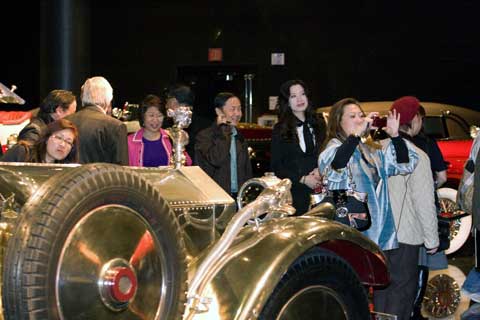 After the formal exchange ceremony, Don Williams proudly takes dignitaries and media on a personal tour of the Blackhawk Museum.
After the formal exchange ceremony, Don Williams proudly takes dignitaries and media on a personal tour of the Blackhawk Museum.
VT: How would Chinese car collectors gain education about the classics of the West? Are there now any Chinese car magazines or websites? Is language a problem?
DW: I’m working to help educate them about what a collector car is, and what it isn’t. We tend to collect the cars we remember from our youth, say 30 years back. Their car history is only 50 years old. Ours is twice that. They have Websites, magazines and now the museum in Shanghai and every major city seems to want a car museum. All publications and Websites are in Chinese, but language is not a problem as all educated people are being taught English. The Shanghai Auto Museum and Blackhawk Pavilion have a variety of cars that give people a well-rounded view of classic cars from around the world. They can learn more in the museum’s library and they can read brochure hand-outs as well.
VT: Any truth that most of the interests on Ferraris, Lamborghinis, Bugattis and Bentleys are towards the new cars, not vintage or classic?
DW: No, the reaction in the museum shows they LOVE cars of the 50’s and 60’s, They want to know about how long cars have been made; they love Citroens from France, Fiats from Italy and German, English, and American cars. They are intrigued to see how antiquated cars are. They’ve seen classic cars in movies and like the looks of them. They are allowed to buy new cars, so they do, but that doesn’t mean they don’t have a passion for older cars once they discover them and they learn about them.
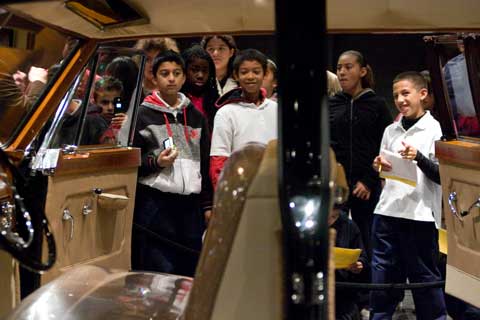
A visiting group of students were among the very first to view the Red Flag at Blackhawk Museum, which excited everyone.
I visted the Blackhawk Collection (or Museum?) last year and found it both and amazing and confusing place. The amazing part were the cars. The confusing part is the aspect of being a museum (or collection?), and also a vintage car dealer. Located in California and/or Las Vegas. Being part of a mall development and also a non-pofit that provides wheelchairs to those in need.
You click on Blackhawk Museum in Google and get the California location, you click on Blackhawk Collection and get the Las Vegas location which has a press release about the Red Flag with the California location on it.
Now I see there is a third entity in China that you are calling a “Pavilion” at a museum. Is this all about a love of cars and hatred for the tax man?
Anyway, some really great cars.
Great interview. I thought your questions and Don’s answers were very insightful and instructive to the collector car world.